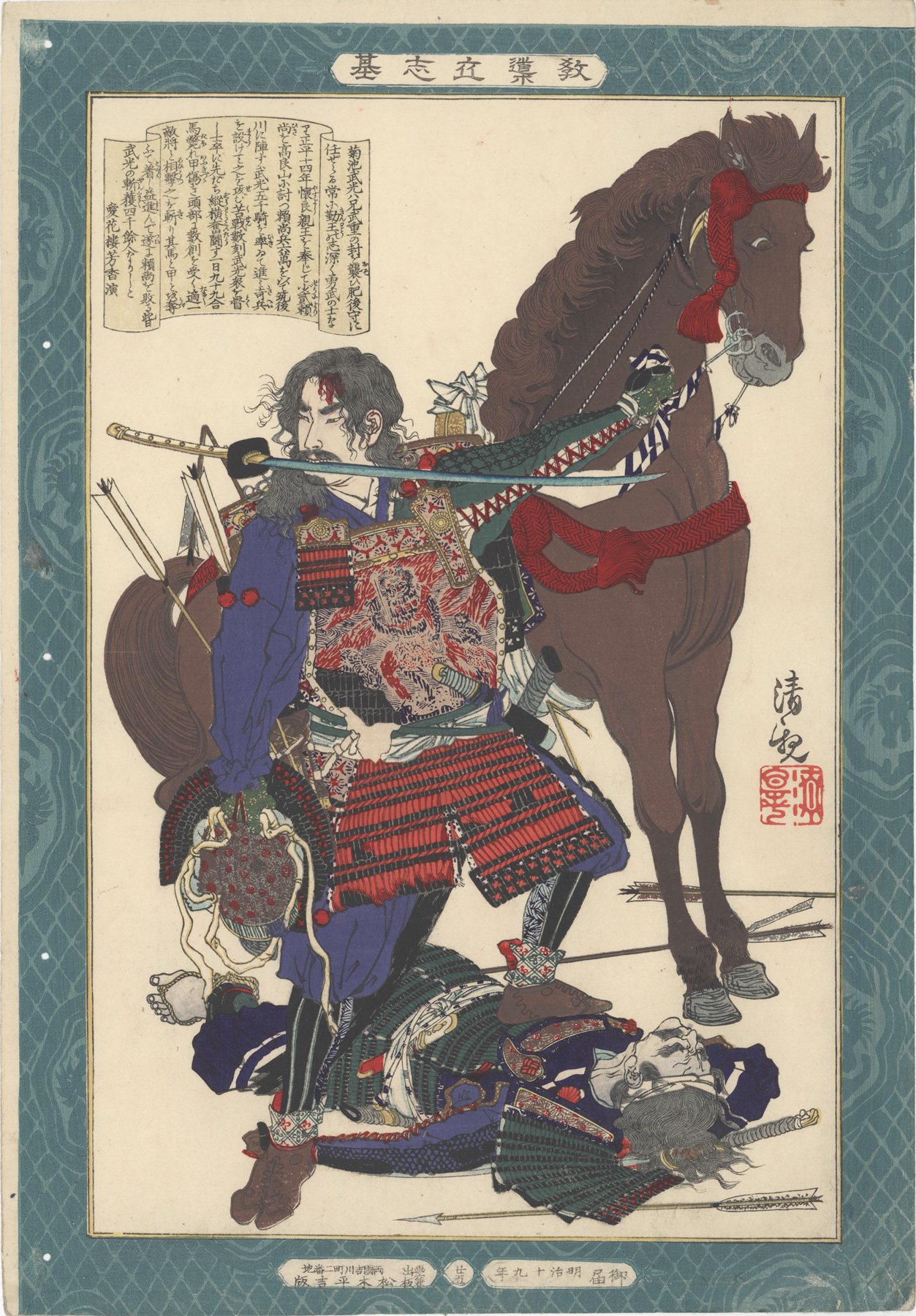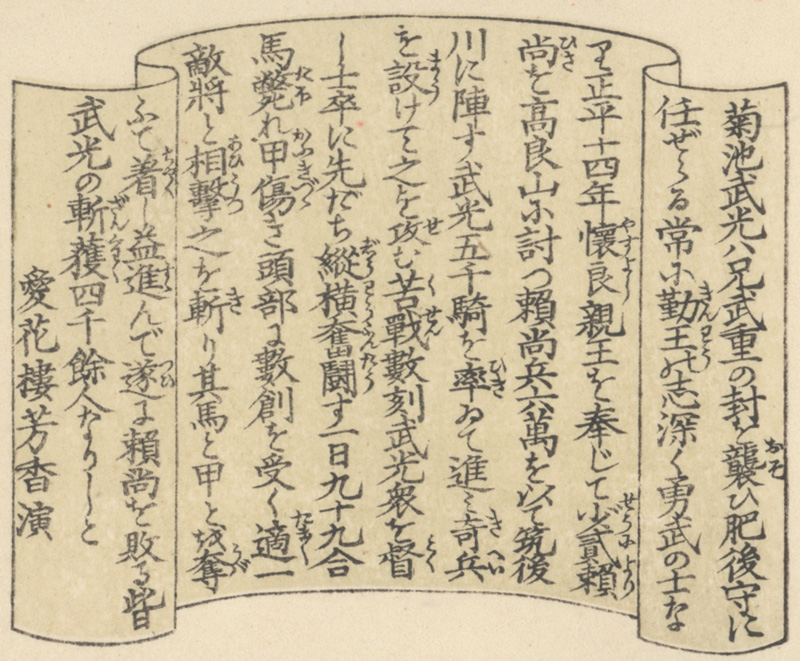Print number 廿五 (25)1 in the series Instructive Models of Lofty Ambition depicts Kikuchi Takemitsu 菊池武光 (1319-1373), a loyal supporter of imperial rule and a military leader of forces loyal to the Southern Dynasty (once led by the Emperor Godaigo), standing over the body of his enemy (likely that of Naosuke Shōni of the Northern Dynasty, loyal to the Ashikaga shogunate.) It is 1359 and the forces of the Southern Dynasty, led by Emperor Godaigo's son Prince Kanenaga 懐良親王 (1329-1383), have defeated the forces of the Northern Dynasty in the Battle of the Chikugo River 筑後川の戦い.
Kiyochika contributed 20 prints to this series. As Smith states: "The style of Kiyochika’s offerings toInstructive Models of Lofty Ambition was decorous and even stiff, as befitted the didactic emphasis of the whole [series.]"2
1 Numbering of the prints was haphazard during the production of the series. Print numbers were sometimes inadvertently omitted; some prints in the series were never assigned numbers and a few of the same numbers appear on different prints.
2 Kiyochika Artist of Meiji Japan, Henry D. Smith II, Santa Barbara Museum of Art, 1988, p. 74.
Source: Imperial Restoration in Medieval Japan, H. Paul Varley, Columbia University Press, 1971, p. 1-3.
The dispute which led to the Battle of the Chikugo River (and many other bloody conflicts), had its origins in the succession dispute that began in the 13th century after ruling powers, formerly exercised by the Imperial Court in Kyoto, had been taken over by a military government (shogunate or bakufu) in Kamakura.
In 1333, however, the then tottering Kamakura Shogunate was overthrown by a coalition of warriors and courtiers and Godaigo (1288-1939), an emperor of one branch of the imperial family. Godaigo attempted to restore the lost authority and prestige of the throne through what came to be known as the Kemmu Restoration. As it became clear that Godaigo's reform were failing, many former allies abandoned his cause.
In 1336 the leading warrior chieftain of the day, Ashikaga Takauji (1305-1358), forced Godaigo to flee from the capital, placed a member of the other branch of the imperial family on the throne and established a new shogunate in Kyoto. Godaigo, however, still regarded himself as the legitimate emperor and set up a rival court at Yoshino in the province of Yamato to the south. For the next half century, from 1336 until 1392, there were two courts in Japan: the northern court, supported and dominated by the Ashikaga, and the southern court of Godaigo and his successors.
This series ran between October 1885 and November 1890 and featured a long list of heroes and heroines, from antiquity to contemporary times, who were regarded as standards of moral leadership and self-realization.
Brief texts contained within a scroll-like cartouche appearing on each print provide historical details. The scroll composer's name is given at the end of the scroll text. The “lofty ambition” of the title is a Confucian concept, originally from Mencius, meaning “righteous determination that would inspire others.” The market for the series probably included former samurai, ambitious youth, and conservative intellectuals.
"[W]hen it was completed in 1890 the publisher was singled out for special recognition by the government for having sponsored such noble subject matter."3
1 The Tokyo Metropolitan Library online collection shows 50 prints and a Table of Contents sheet. The Table of Contents lists the titles of 50 prints. Smith in Kiyochika Artist of Meiji Japan identified 52 prints. I have identified 58 prints from this series including five prints (Ikina, Michizane Sugiwara, Kesa Gozen, Soga Brothers and Hokiichi Hanawa) that were re-designed and re-printed, likely due to damaged or lost blocks.
2 Robert Schaap notes in Appendix II, p. 166 of Yoshitoshi, Masterpieces from the Ed Freis Collection, Chris Uhlenbeck and Amy Reigle Newland, Hotei Publishing, 2011 that the series originally appeared as newspaper supplements.
3 The World of the Meiji Print: Impressions of a New Civilization, Julia Meech-Pekarik, Weatherhill, 1986, p. 122.
Takemitsu Kikuchi and the Battle of the Chikugo River (Battle of Ohubara)
Source: Legends and Stories Around the Japanese Sword, Markus Sesko, Herstellung und Verlag: Books on Demand GmbH, Norderstedt, 2011, p. 78-79.The death of Emperor Godaigo in 1339 did not end the dispute between the Northern and Southern Dynasties. Prince Kanenaga , Emperor Godaigo's son, was supported by the Kikuchi and Aso clans against the Northern Dynasty and the Shōni clan, loyal to the Ashikaga shogun Northern Dynasty.
In the fourth year of Enbun (1359), Prince Kanenaga faced an upcoming attack from the Ashikaga, represented by Shōni Yorinao 少貳頼尚 (1293-1371) who switched to the side of the bakufu some years earlier. Kikuchi Takemitsu (1319-1373) and other generals were mobilized and an army of about 40,000 men took position on the northern coast of the Chikugo River, faced with an alliance of about 60,000 warriors. The battle was very brutal and records say that altogether 26,000 men were killed on both sides.
Kikuchi Takemitsu and his allies were victorious and this secured the supremacy of the Southern Dynasty on Kyushu for about ten years. A vivid insight into the fierceness of this conflict is given to us some 500 years later by the historian and poet Rai San’yo (1780-1832):Onwounded horses, the armour broken, but now more than usual! The enemy is killed, his helmet is removed,and his horse is taken. Pierced byarrows they look like hedgehogs, the skin around the corners of the eyes istorn open and bleeding. […] The river sounded like roaring laughter when theywere cleaning their swords in it on the way back home. The blood ran down in streams so that theglacier turned red last this year.
Transcription of Scroll
25 Kikuchi Takemitsu 菊池武光
教導立志基 廿五 菊池武光 小林清親 1886年
Transcription:
“菊池武光ハ兄武重の封を襲ひ肥後守に任ぜらる常に勤王の志深く勇武の士なり 正平十四年懐良親王を奉じて少貳頼尚を高良山に討つ 頼尚兵六萬を以て筑後川に陣す 武光五千騎を率ゐて進ミ奇兵を設けて之を攻む苦戦數刻 武光衆を督し士卒に先だち縦横奮闘す 一日九十九合 馬斃れ甲傷き頭部に數創を受く 適(たま/\)一敵将と相撃之を斬り其馬と甲とを奪ふて着し益進んで遂に頼尚を敗る 此日武光の斬獲四千餘人なりしと 愛花樓芳香 演”
About The Series "Kyōdō risshi no motoi"
Notes:
1. This series is variously translated as "Instructive Models of Lofty Ambition," "Foundations of Learning and Achievement," "Foundation of Instruction and Perseverance," "Self-Made Men Worthy of Emulation," "Paragons of Instruction and Success," "Moral of Success," "Examples of Self-Made Leaders," and "Instruction in the Fundamentals of Success." The title in Japanese is sometimes seen as "Kyōdō risshiki or "Kyōdō risshi no moto," in addition to the most commonly seen transliteration of "Kyōdō risshi no motoi".
2. For a complete listing of all the prints in the series and additional information please see the article on this site titled Instructive Models of Lofty Ambition.
This series ran between October 1885 and November 1890 and featured a long list of heroes and heroines, from antiquity to contemporary times, who were regarded as standards of moral leadership and self-realization.
Source: Kiyochika Artist of Meiji Japan, Henry D. Smith II, Santa Barbara Museum of Art, 1988, p. 74-75; original research and as footnoted.
This series of 58 prints,1 plus a table of contents sheet (目録), were originally published between October 1885 and November 1890 by the Tokyo publisher Matsuki Heikichi 松木平吉.2 The table of contents sheet issued by the publisher states that "fifty prints make up the complete set (五十番揃)". Three prints not in the initial release were added over the five year publication period, as were five redesigns of original prints, eventually increasing the total print count to 58. The seven artists contributing prints were Kobayashi Kiyochika (1847-1915) [20 prints], Mizuno Toshikata (1866-1908) [16 prints], Inoue Tankei (Yasuji) (1864-1889) [13 prints], Taiso (Tsukioka) Yoshitoshi (1839-1892) [5 prints], Yōshū Chikanobu (1838-1912) [2 prints], Toyohara Kunichika (1835–1900) [1 print], and Hachisuka (Utagawa) Kuniaki II (1835-1888) [1 print]. All the artists, with the exception of Yōshū Chikanobu, are listed in the top scroll of the table of contents sheet. Various colors (including blue, blue/green, and tan/brown) were used for the decorative border, and in 1902 the series was re-issued by Matsuki without borders.
This series of 58 prints,1 plus a table of contents sheet (目録), were originally published between October 1885 and November 1890 by the Tokyo publisher Matsuki Heikichi 松木平吉.2 The table of contents sheet issued by the publisher states that "fifty prints make up the complete set (五十番揃)". Three prints not in the initial release were added over the five year publication period, as were five redesigns of original prints, eventually increasing the total print count to 58. The seven artists contributing prints were Kobayashi Kiyochika (1847-1915) [20 prints], Mizuno Toshikata (1866-1908) [16 prints], Inoue Tankei (Yasuji) (1864-1889) [13 prints], Taiso (Tsukioka) Yoshitoshi (1839-1892) [5 prints], Yōshū Chikanobu (1838-1912) [2 prints], Toyohara Kunichika (1835–1900) [1 print], and Hachisuka (Utagawa) Kuniaki II (1835-1888) [1 print]. All the artists, with the exception of Yōshū Chikanobu, are listed in the top scroll of the table of contents sheet. Various colors (including blue, blue/green, and tan/brown) were used for the decorative border, and in 1902 the series was re-issued by Matsuki without borders.
Brief texts contained within a scroll-like cartouche appearing on each print provide historical details. The scroll composer's name is given at the end of the scroll text. The “lofty ambition” of the title is a Confucian concept, originally from Mencius, meaning “righteous determination that would inspire others.” The market for the series probably included former samurai, ambitious youth, and conservative intellectuals.
"[W]hen it was completed in 1890 the publisher was singled out for special recognition by the government for having sponsored such noble subject matter."3
1 The Tokyo Metropolitan Library online collection shows 50 prints and a Table of Contents sheet. The Table of Contents lists the titles of 50 prints. Smith in Kiyochika Artist of Meiji Japan identified 52 prints. I have identified 58 prints from this series including five prints (Ikina, Michizane Sugiwara, Kesa Gozen, Soga Brothers and Hokiichi Hanawa) that were re-designed and re-printed, likely due to damaged or lost blocks.
2 Robert Schaap notes in Appendix II, p. 166 of Yoshitoshi, Masterpieces from the Ed Freis Collection, Chris Uhlenbeck and Amy Reigle Newland, Hotei Publishing, 2011 that the series originally appeared as newspaper supplements.
3 The World of the Meiji Print: Impressions of a New Civilization, Julia Meech-Pekarik, Weatherhill, 1986, p. 122.
Print Details
| IHL Catalog | #1398 |
| Title or Description | Takemitsu Kikuchi 菊地武光 |
| Series | “Instructive Models of Lofty Ambition” (Kyodo risshiki 教導立志基) [note: series title also listed as 'Kyodo Risshi no Moto', ‘Kyodo risshi no motoi’, ‘Kyōdō risshi ki’ and variously translated as “Moral of success” or “Foundations of learning and achievement” or “Self-made Men Worthy of Emulation”' or “Examples of Self-made Leaders” or "Paragons of instruction and success"] |
| Artist | Kiyochika Kobayashi (1847-1915) |
| Signature |  |
| Seal | Kiyochika 清親 below signature (as shown above) |
| Publication Date | May 1886 明治十九年 |
| Publisher | Matsuki Heikichi (松木平吉) proprietor of Daikokuya Heikichi [Marks: seal not shown; pub. ref. 029] |
| Impression | excellent |
| Colors | excellent |
| Condition | good - not backed; almost full-size sheet; soiling and rubbing top left and bottom right corners of brocade border; glue discoloration verso left, bottom, top margin; five small binding holes left margin |
| Genre | ukiyo-e; rishki-e; kyōiku nishiki-e |
| Miscellaneous | print number 廿五 (25); position 25 in the Table of Contents for the series. |
| Format | vertical oban |
| H x W Paper | 14 1/2 x 10 in. (36.8 x 25.4 cm) |
| H x W Image | 14 1/4 x 9 13/16 in. (36.2 x 24.9 cm) 12 5/8 x 8 1/4 in. (32.1 x 21 cm) area inside brocade border |
| Literature | |
| Collections This Print | British Museum 1906,1220,0.1815; Edo-Tokyo Museum 96200386; Tokyo Metropolitan Library 280-K15; Smithsonian Institution Freer Sackler S1995.116.7 (green border) |



